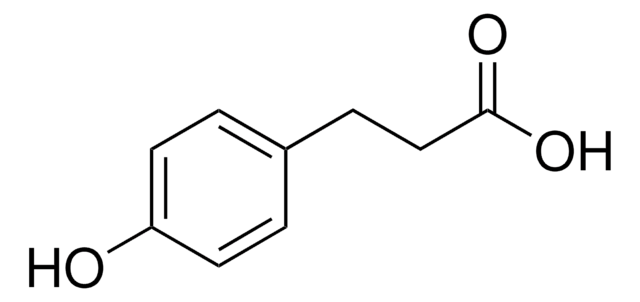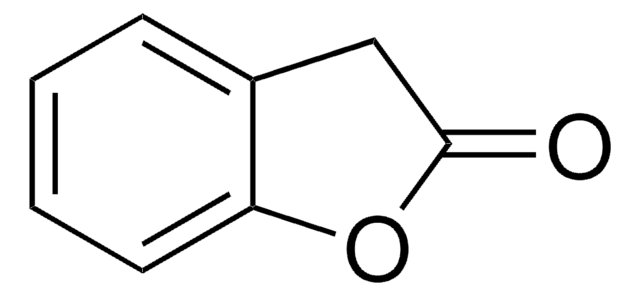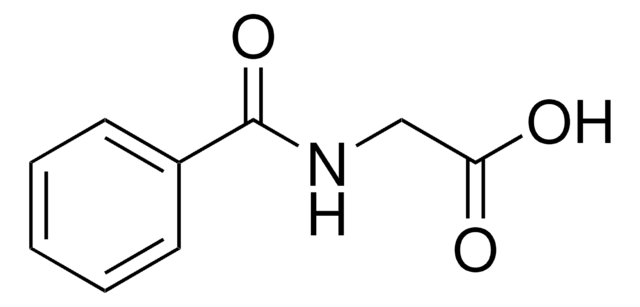H49804
2-ヒドロキシフェニル酢酸
ReagentPlus®, 99%
別名:
(2-Hydroxyphenyl)acetic acid, (o-Hydroxyphenyl)acetic acid, 2-(2-Hydroxyphenyl)acetic acid, 2-(2′-Hydroxyphenyl)acetic acid, 2-HPAA, 2-Hydroxybenzeneacetic acid
ログイン組織・契約価格を表示する
すべての画像(1)
About This Item
化学式:
HOC6H4CH2CO2H
CAS番号:
分子量:
152.15
Beilstein:
908000
EC Number:
MDL番号:
UNSPSCコード:
12352100
PubChem Substance ID:
NACRES:
NA.22
おすすめの製品
製品種目
ReagentPlus®
アッセイ
99%
mp
145-147 °C (lit.)
SMILES記法
OC(=O)Cc1ccccc1O
InChI
1S/C8H8O3/c9-7-4-2-1-3-6(7)5-8(10)11/h1-4,9H,5H2,(H,10,11)
InChI Key
CCVYRRGZDBSHFU-UHFFFAOYSA-N
類似した製品をお探しですか? 訪問 製品比較ガイド
法的情報
ReagentPlus is a registered trademark of Merck KGaA, Darmstadt, Germany
シグナルワード
Warning
危険有害性情報
危険有害性の分類
Eye Irrit. 2 - Skin Irrit. 2 - STOT SE 3
ターゲットの組織
Respiratory system
保管分類コード
11 - Combustible Solids
WGK
WGK 3
引火点(°F)
Not applicable
引火点(℃)
Not applicable
個人用保護具 (PPE)
dust mask type N95 (US), Eyeshields, Gloves
適用法令
試験研究用途を考慮した関連法令を主に挙げております。化学物質以外については、一部の情報のみ提供しています。 製品を安全かつ合法的に使用することは、使用者の義務です。最新情報により修正される場合があります。WEBの反映には時間を要することがあるため、適宜SDSをご参照ください。
Jan Code
H49804-25G:
H49804-10G:
H49804-VAR:
H49804-BULK:
Tania Irebo et al.
Journal of the American Chemical Society, 130(29), 9194-9195 (2008-06-28)
Proton coupled electron transfer (PCET) from tyrosine covalently linked to Ru(bpy)32+ has been studied with laser flash-quench techniques. Two new complexes with internal hydrogen bonding bases to the phenolic proton have been synthesized. Depending on the hydrogen bonding and protonation
D Ratanasavanh et al.
Fundamental & clinical pharmacology, 10(6), 504-510 (1996-01-01)
We compared the cytotoxic effect of coumarin and its derivatives, 7-hydroxycoumarin (7-OHC), 4-hydroxycoumarin (4-OHC), o-hydroxyphenyl acetic acid (OHPAA) and o-coumaric acid (CA), on cultured hepatocytes from human, rat, mouse and rabbit liver. At 10(-5) and 5 x 10(-5) M, coumarin
M Bayat-Sarmadi et al.
Molecular and cellular endocrinology, 92(1), 127-134 (1993-03-01)
Prolactin has many known functions and one of them is to induce the expression of milk protein gene expression in the mammary gland. Specific membrane receptors have been recently characterized but the transduction mechanism involved in the transfer of the
S L Born et al.
Food and chemical toxicology : an international journal published for the British Industrial Biological Research Association, 41(2), 247-258 (2002-12-14)
Coumarin, a well recognized rat hepatotoxicant, also causes acute, selective necrosis of terminal bronchiolar Clara cells in the mouse lung. Further, chronic oral gavage administration of coumarin at 200 mg/kg, a dose that causes Clara cell death, resulted in a
Jeffrey D Vassallo et al.
Toxicological sciences : an official journal of the Society of Toxicology, 80(2), 249-257 (2004-05-14)
Hepatotoxicity of coumarin is attributed to metabolic activation to an epoxide intermediate, coumarin 3,4-epoxide (CE). However, whereas rats are most susceptible to coumarin-induced hepatotoxicity, formation of CE is greatest in mouse liver microsomes, a species showing little evidence of hepatotoxicity.
ライフサイエンス、有機合成、材料科学、クロマトグラフィー、分析など、あらゆる分野の研究に経験のあるメンバーがおります。.
製品に関するお問い合わせはこちら(テクニカルサービス)








